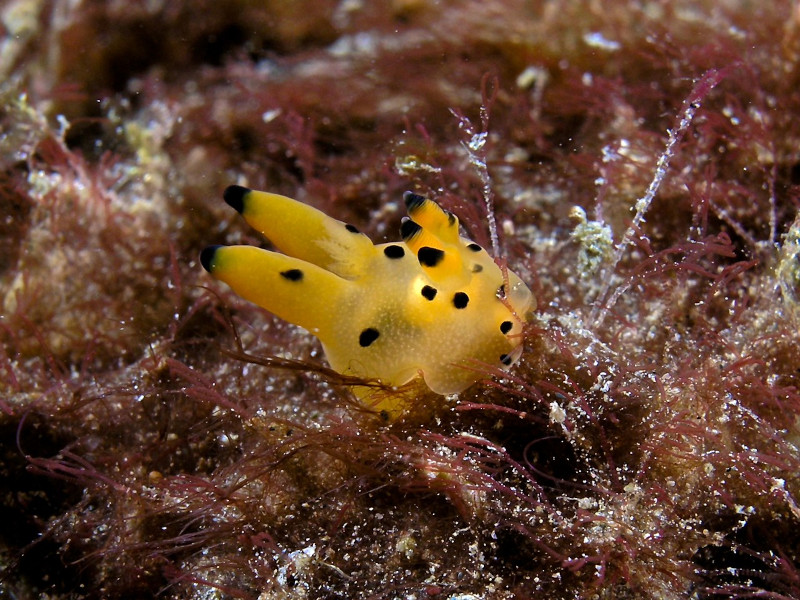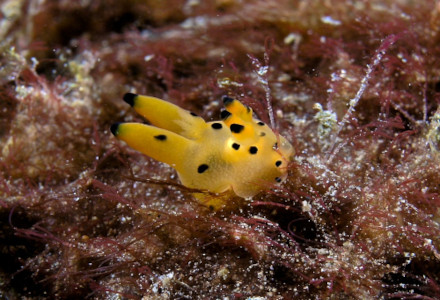
Pikachu Nudibranch Facts
- This eye-catching marvel of Nature frequently goes by the equally attention-grabbing common name of the Pikachu Nudibranch. For the moment, unlike the majority of species around the world, it has no other generally accepted common name.
- Among scientific professionals, however, such as researchers, it’s typically referred to by its official name. That term, though remains somewhat hard for the layman to pronounce, as often occurs. That’s because it bears the moniker of Thecacera pacifica.
- It further recieved that slightly tongue-twisting technical name due to the work of the Danish researcher, Rudolph Bergh. He recorded the first official recognition of the animal as a separate and distinct species. This action noteworthy occured in 1883.
- For the moment, the Pikachu Nudibranch appears to be maintaining a population base that’s both stable and sufficient. This trend also seems to hold true throughout the entirety of its native range. The IUCN, therefore, currently has no listing for it.
- The intriguing Gastropod nevertheless must be considered to be facing at least some potential threats to its existence. These, though, consist of the same perils facing most species today. The greatest of there, however, likely consists of climate change.
Related Articles
Pikachu Nudibranch Physical Description
The amazing Pikachu Nudibranch easily draws the eye of those fortunate to encounter it in Nature. The remarkable Mollusc does so, however, for reasons unrelated to sheer size. That’s because this marvel of evolution developed as smaller than many of its kindred.
In this respect, it also stands out from many other creatures in the world. That’s true since the tiny wonder qualifies as a hermaphrodite. Thus, individuals remain both male and female. The physiological trait of sexual dimorphism, therefore, does not apply to it.
In terms of pure size, though, individuals vary widely in this respect. That principally occurs due to various environmental facctors. An average-sized mature adult, though, measures roughly 0.8 (2 cm) in length. Exceptional specimens do nevertheless occur, yet remain rare.
It’s the overall physical appearance of the Pikachu Nudibranch, though, that garners most of the attention. As its very name suggests, in the minds of many it bears a striking resemblance to the Pokémon character named Pikachu. Its one of Nataure’s many coincidences.
That’s due to the overall color scheme. The majority of the small body manifests as a translucent yellow to yellowish-orange color. Its several sheaths, however, present black edges with blue patches. Black tips also appear around the gills, with blue at the tip of its tail.
- Kingdom: Animalia
- Phylum: Mollusca
- Class: Gastropoda
- Order: Nudibranchia
- Family: Polyceridae
- Genus: Thecacera
- Species: T. pacifica
Pikachu Nudibranch Distribution, Habitat, and Ecology
Fortunately, both for the Pikachu Nudibranch itself, and those who appreciate Nature, it evolved as endemic to a relatively broad swathe of the globe. Not surprisingly, though, that area happens to be well known for its abundance of impressive marine species.
More precisely, evidence indicates that the intriguing animal inhabits a wide section of the Indian Ocean. It also appears in many regions of the western Pacific. For the moment, research indicates that it never existed outside of that range. Research is ongoing, however.
This impressive little creature also seems to prefer the shallower depths. That’s the case for many of its relatives. Due to that tendency, it’s almost always found comparatively close to the shoreline. This holds true whether that’s the shoreline of the continent or an island.
Some of the regions where it’s most frequently spotted include the African coast, Vanuatu, and Indonesia. It’s also been spotted in smaller numbers in the Gulf of Mexico. In all areas in which it appears, though, it’s never been spotted at depths greater than 62.3 ft (19 m).
Like the majority of its related species, the Pikachu Nudibranch evolved as carnivorous in nature. In its specific case, due to its sheer size, its prey remains small. This most commonly consists of locally available quantities of algae and plankton, as well as small jellyfish.
Researchers currentlyknow very little about many aspects of its life. That includes its lifespan. For similar species, however, this ranges from a few weeks to a few years. One thing that scientists do known, though, is that, like many other nudibranches, it quite toxic.
Species Sharing Its Range
Check out our other articles on 4 Fabulous Flora of Florida, Texas Blind Salamander, Uluru, Caspian Seal, New Guinea Crocodile, Peacock Butterfly, Canary Island Date Palm

